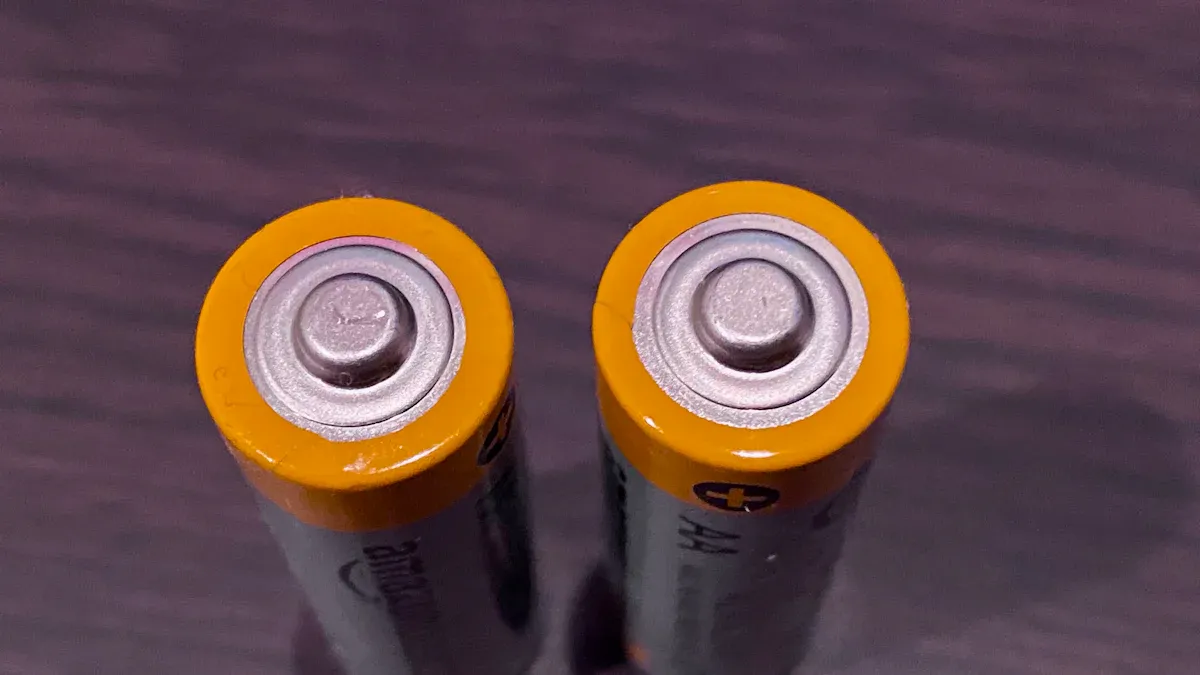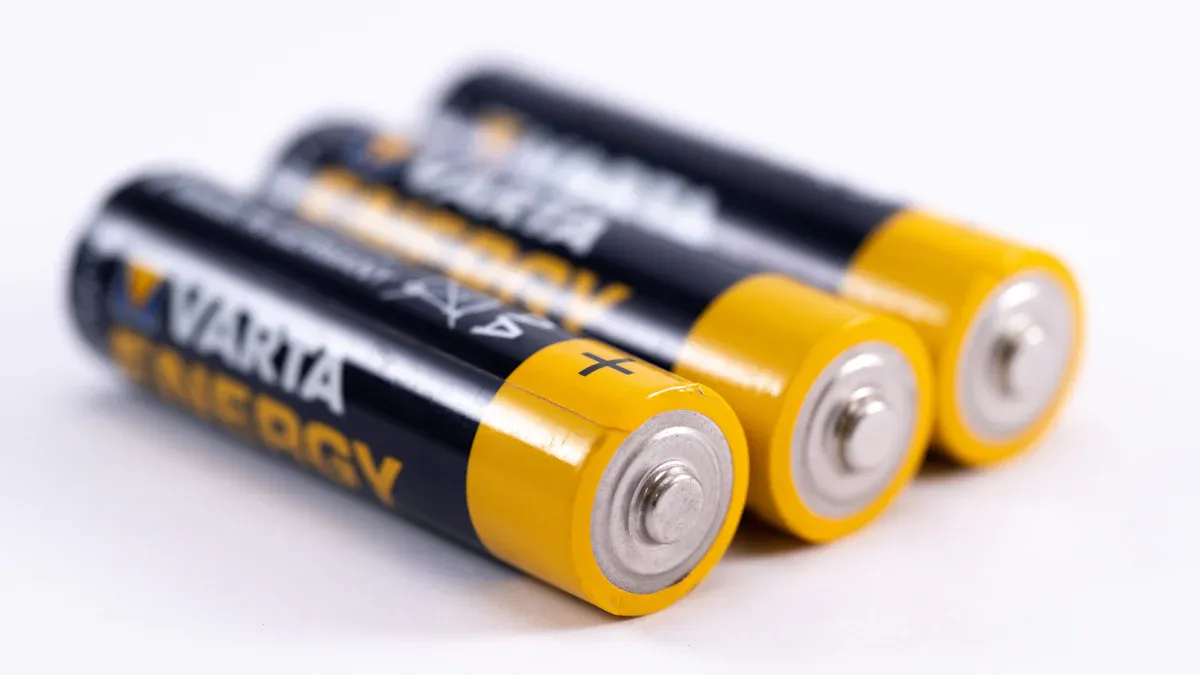
When I compare an Alkaline Battery to a regular carbon-zinc battery, I see clear differences in chemical composition. Alkaline batteries use manganese dioxide and potassium hydroxide, while carbon-zinc batteries rely on a carbon rod and ammonium chloride. This results in longer lifespan and better performance for alkaline batteries.
Key Point: Alkaline batteries last longer and work better because of their advanced chemistry.
Key Takeaways
- Alkaline batteries last longer and provide steadier power than regular carbon-zinc batteries because of their advanced chemical design.
- Alkaline batteries work best in high-drain and long-term devices like cameras, toys, and flashlights, while carbon-zinc batteries suit low-drain, budget-friendly devices like clocks and remote controls.
- Although alkaline batteries cost more upfront, their longer life and better performance save money over time and protect your devices from leaks and damage.
Alkaline Battery: What Is It?

Chemical Composition
When I examine the structure of an Alkaline Battery, I notice several important components.
- Zinc powder forms the anode, which releases electrons during operation.
- Manganese dioxide acts as the cathode, accepting electrons to complete the circuit.
- Potassium hydroxide serves as the electrolyte, allowing ions to move and enabling the chemical reaction.
- All these materials are sealed inside a steel casing, which provides durability and safety.
In summary, the Alkaline Battery uses zinc, manganese dioxide, and potassium hydroxide to deliver reliable power. This combination sets it apart from other battery types.
How Alkaline Batteries Work
I see that the Alkaline Battery operates through a series of chemical reactions.
- Zinc at the anode undergoes oxidation, releasing electrons.
- These electrons travel through an external circuit, powering the device.
- Manganese dioxide at the cathode accepts the electrons, completing the reduction reaction.
- Potassium hydroxide allows ions to flow between electrodes, maintaining charge balance.
- The battery generates electricity only when connected to a device, with a typical voltage of about 1.43 volts.
To sum up, the Alkaline Battery converts chemical energy into electrical energy by moving electrons from zinc to manganese dioxide. This process powers many everyday devices.
Common Applications
I often use Alkaline Batteries in a wide range of devices.
- Remote controls
- Clocks
- Cameras
- Electronic toys
These devices benefit from the Alkaline Battery’s stable voltage, long working time, and high energy density. I rely on this battery for consistent performance in both low-drain and high-drain electronics.
In short, the Alkaline Battery is a popular choice for household and electronic devices because it offers dependable power and long-lasting performance.
Regular Battery: What Is It?
Chemical Composition
When I look at a regular battery, I see that it is usually a carbon-zinc battery. The anode consists of zinc metal, often shaped as a can or alloyed with small amounts of lead, indium, or manganese. The cathode contains manganese dioxide mixed with carbon, which improves conductivity. The electrolyte is an acidic paste, typically made from ammonium chloride or zinc chloride. During use, zinc reacts with manganese dioxide and the electrolyte to produce electricity. For example, the chemical reaction with ammonium chloride can be written as Zn + 2MnO₂ + 2NH₄Cl → Zn(NH₃)₂Cl₂ + 2MnOOH. This combination of materials and reactions defines the carbon-zinc battery.
In summary, a regular battery uses zinc, manganese dioxide, and an acidic electrolyte to create electrical energy through chemical reactions.
How Regular Batteries Work
I find that the operation of a carbon-zinc battery relies on a series of chemical changes.
- Zinc at the anode loses electrons, forming zinc ions.
- Electrons travel through the external circuit, powering the device.
- Manganese dioxide at the cathode gains electrons, completing the reduction process.
- The electrolyte, such as ammonium chloride, supplies ions to balance the charges.
- Ammonia forms during the reaction, which helps dissolve zinc ions and keeps the battery working.
| Component | Role/Reaction Description | Chemical Equation(s) |
|---|---|---|
| Negative Electrode | Zinc oxidizes, losing electrons. | Zn – 2e⁻ = Zn²⁺ |
| Positive Electrode | Manganese dioxide reduces, gaining electrons. | 2MnO₂ + 2NH₄⁺ + 2e⁻ = Mn₂O₃ + 2NH₃ + H₂O |
| Overall Reaction | Zinc and manganese dioxide react with ammonium ions. | 2Zn + 2MnO₂ + 2NH₄⁺ = 2Zn²⁺ + Mn₂O₃ + 2NH₃ + H₂O |
To sum up, a regular battery produces electricity by moving electrons from zinc to manganese dioxide, with the electrolyte supporting the process.
Common Applications
I often use regular carbon-zinc batteries in devices that do not require much power.
- Remote controls
- Wall clocks
- Smoke detectors
- Small electronic toys
- Portable radios
- Flashlights used occasionally
These batteries work well in devices with low energy needs. I choose them for cost-effective power in household items that run for long periods without heavy use.
In short, regular batteries are ideal for low-drain devices like clocks, remotes, and toys because they provide affordable and reliable energy.
Alkaline Battery vs. Regular Battery: Key Differences

Chemical Makeup
When I compare the internal structure of an Alkaline Battery to a regular carbon-zinc battery, I notice several important differences. The Alkaline Battery uses zinc powder as the negative electrode, which increases the surface area and boosts reaction efficiency. Potassium hydroxide serves as the electrolyte, providing higher ionic conductivity. The positive electrode consists of manganese dioxide surrounding the zinc core. In contrast, a carbon-zinc battery uses a zinc casing as the negative electrode and an acidic paste (ammonium chloride or zinc chloride) as the electrolyte. The positive electrode is manganese dioxide lining the inside, and a carbon rod acts as the current collector.
| Component | Alkaline Battery | Carbon-Zinc Battery |
|---|---|---|
| Negative Electrode | Zinc powder core, high reaction efficiency | Zinc casing, slower reaction, may corrode |
| Positive Electrode | Manganese dioxide surrounds zinc core | Manganese dioxide lining |
| Electrolyte | Potassium hydroxide (alkaline) | Acidic paste (ammonium/zinc chloride) |
| Current Collector | Nickel-plated bronze rod | Carbon rod |
| Separator | Advanced separator for ion flow | Basic separator |
| Design Features | Improved sealing, less leakage | Simpler design, higher corrosion risk |
| Performance Impact | Higher energy density, longer life, steady power | Lower energy, less steady, faster wear |
Key Point: The Alkaline Battery features a more advanced chemical and structural design, resulting in higher efficiency and better performance than regular carbon-zinc batteries.
Performance and Lifespan
I see a clear difference in how these batteries perform and how long they last. Alkaline batteries deliver a higher energy density, which means they store and provide more power for longer periods. They also maintain a steady voltage, making them ideal for devices that need consistent energy. In my experience, the shelf life of an Alkaline Battery ranges from 5 to 10 years, depending on storage conditions. Carbon-zinc batteries, on the other hand, typically last only 1 to 3 years and work best in low-drain devices.
| Battery Type | Typical Lifespan (Shelf Life) | Usage Context and Storage Recommendations |
|---|---|---|
| Alkaline | 5 to 10 years | Best for high-drain and long-term use; store cool and dry |
| Carbon-Zinc | 1 to 3 years | Suitable for low-drain devices; lifespan shortens in high-drain use |
In high-drain devices like cameras or motorized toys, I find that Alkaline batteries outperform carbon-zinc batteries by lasting much longer and providing more reliable power. Carbon-zinc batteries tend to lose power quickly and may leak if used in demanding devices.
Key Point: Alkaline batteries last much longer and perform better, especially in devices that require steady or high power.
Cost Comparison
When I shop for batteries, I notice that Alkaline batteries usually cost more upfront than carbon-zinc batteries. For example, a 2-pack of AA Alkaline batteries might cost around $1.95, while a 24-pack of carbon-zinc batteries could be priced at $13.95. However, the longer lifespan and better performance of Alkaline batteries mean I replace them less often, which saves money over time. For frequent users, the total cost of ownership for Alkaline batteries is often lower, even though the initial price is higher.
| Battery Type | Example Product Description | Pack Size | Price Range (USD) |
|---|---|---|---|
| Alkaline | Panasonic AA Alkaline Plus | 2-pack | $1.95 |
| Alkaline | Energizer EN95 Industrial D | 12-pack | $19.95 |
| Carbon-Zinc | Player PYR14VS C Extra Heavy Duty | 24-pack | $13.95 |
| Carbon-Zinc | Player PYR20VS D Extra Heavy Duty | 12-pack | $11.95 – $19.99 |
- Alkaline batteries provide more stable voltage and last longer, reducing replacement frequency.
- Carbon-zinc batteries are cheaper upfront but need to be replaced more often, especially in high-drain devices.
Key Point: Although Alkaline batteries cost more at first, their longer life and better performance make them more cost-effective for regular use.
Environmental Impact
I always consider the environmental impact when choosing batteries. Both Alkaline and carbon-zinc batteries are single-use and contribute to landfill waste. Alkaline batteries contain heavy metals like zinc and manganese, which can pollute soil and water if not disposed of properly. Their production also requires more energy and resources. Carbon-zinc batteries use less harmful electrolytes, but their shorter lifespan means I dispose of them more frequently, increasing waste.
- Alkaline batteries have higher energy density but pose a greater environmental risk due to heavy metal content and resource-intensive production.
- Carbon-zinc batteries use ammonium chloride, which is less toxic, but their frequent disposal and risk of leakage can still harm the environment.
- Recycling both types helps conserve valuable metals and reduces pollution.
- Proper disposal and recycling are essential to minimize environmental harm.
Key Point: Both battery types impact the environment, but responsible recycling and disposal can help reduce pollution and conserve resources.
Alkaline Battery: Which Lasts Longer?
Lifespan in Everyday Devices
When I compare battery performance in everyday devices, I notice a clear difference in how long each type lasts. For example, in remote controls, an Alkaline Battery typically powers the device for about three years, while a carbon-zinc battery lasts around 18 months. This longer lifespan comes from the higher energy density and more stable voltage that alkaline chemistry provides. I find that devices like clocks, remote controls, and wall-mounted sensors work reliably for longer periods when I use alkaline batteries.
| Battery Type | Typical Lifespan in Remote Controls |
|---|---|
| Alkaline Battery | About 3 years |
| Carbon-Zinc Battery | Around 18 months |
Key Point: Alkaline batteries last almost twice as long as carbon-zinc batteries in most household devices, making them a better choice for long-term use.
Performance in High-Drain and Low-Drain Devices
I see that the type of device also affects battery performance. In high-drain devices like digital cameras or motorized toys, alkaline batteries deliver steady power and last much longer than carbon-zinc batteries. For low-drain devices such as clocks or remote controls, alkaline batteries provide a stable voltage and resist leakage, which protects my devices and reduces maintenance.
- Alkaline batteries hold up better under constant load and maintain charge longer.
- They have a lower risk of leaking, which keeps my electronics safe.
- Carbon-zinc batteries work best in ultra low-drain or disposable devices where cost is the main concern.
| Attribute | Carbon-Zinc Battery | Alkaline Battery |
|---|---|---|
| Energy Density | 55-75 Wh/kg | 45-120 Wh/kg |
| Lifespan | Up to 18 months | Up to 3 years |
| Safety | Prone to electrolyte leakage | Lower risk of leakage |
Key Point: Alkaline batteries outperform carbon-zinc batteries in both high-drain and low-drain devices, offering longer life, better safety, and more reliable power.
Alkaline Battery: Cost-Effectiveness
Upfront Price
When I shop for batteries, I notice a clear difference in the initial price between types. Here’s what I observe:
- Carbon-zinc batteries usually have a lower upfront cost. Manufacturers use simpler materials and production methods, which keeps prices down.
- These batteries are budget-friendly and work well for devices that do not need much power.
- Alkaline batteries cost more at the start. Their advanced chemistry and higher energy density justify the higher price.
- I find that the extra cost often reflects better performance and longer life.
Key Point: Carbon-zinc batteries save money at the checkout, but alkaline batteries offer more advanced technology and longer-lasting power for a slightly higher price.
Value Over Time
I always consider how long a battery lasts, not just the price tag. Alkaline batteries may cost more upfront, but they deliver more hours of use, especially in high-drain devices. For example, in my experience, an alkaline battery can last about three times longer than a carbon-zinc battery in demanding electronics. This means I replace batteries less often, which saves money over time.
| Feature | Alkaline Battery | Carbon-Zinc Battery |
|---|---|---|
| Cost per Unit (AA) | Approximately $0.80 | Approximately $0.50 |
| Lifespan in High-Drain | About 6 hours (3x longer) | About 2 hours |
| Capacity (mAh) | 1,000 to 2,800 | 400 to 1,000 |
Although carbon-zinc batteries cost about 40% less per unit, I find that their shorter lifespan leads to a higher cost per hour of use. Alkaline batteries provide better value in the long run, especially for devices that need steady or frequent power.
Key Point: Alkaline batteries cost more at first, but their longer life and higher capacity make them a smarter investment for most electronics.
Choosing Between Alkaline Battery and Regular Battery
Best for Remote Controls and Clocks
When I select batteries for remote controls and clocks, I look for reliability and value. These devices use very little power, so I want a battery that lasts a long time without frequent replacement. Based on my experience and expert recommendations, I find that alkaline batteries work best for these low-drain devices. They are easy to find, moderately priced, and provide steady power for months or even years. Lithium batteries last even longer, but their higher price makes them less practical for everyday items like remotes and clocks.
- Alkaline batteries are the most common choice for remote controls and clocks.
- They offer a good balance between cost and performance.
- I rarely need to replace them in these devices.
Key Point: For remote controls and clocks, alkaline batteries deliver dependable, long-lasting power at a reasonable price.
Best for Toys and Electronics
I often use toys and electronic gadgets that need more energy, especially those with lights, motors, or sound. In these cases, I always choose alkaline batteries over carbon-zinc. Alkaline batteries have a much higher energy density, so they keep toys running longer and protect devices from leaks. They also perform better in both hot and cold conditions, which matters for outdoor toys.
| Feature | Alkaline Batteries | Carbon-Zinc Batteries |
|---|---|---|
| Energy Density | High | Low |
| Lifespan | Long | Short |
| Leakage Risk | Low | High |
| Performance in Toys | Excellent | Poor |
| Environmental Impact | More eco-friendly | Less eco-friendly |
Key Point: For toys and electronics, alkaline batteries provide longer playtime, better safety, and more reliable performance.
Best for Flashlights and High-Drain Devices
When I need power for flashlights or other high-drain devices, I always reach for alkaline batteries. These devices draw a lot of current, which quickly drains weaker batteries. Alkaline batteries maintain a steady voltage and last much longer in demanding situations. Experts advise against using carbon-zinc batteries in high-drain devices because they lose power quickly and may leak, which can damage the device.
- Alkaline batteries handle high-drain loads better.
- They keep flashlights bright and reliable during emergencies.
- I trust them for professional tools and household safety devices.
Key Point: For flashlights and high-drain devices, alkaline batteries are the best choice for lasting power and device protection.
When I compare alkaline and carbon-zinc batteries, I see clear differences in chemistry, lifespan, and performance:
| Aspect | Alkaline Batteries | Carbon-Zinc Batteries |
|---|---|---|
| Lifespan | 5–10 years | 2–3 years |
| Energy Density | Higher | Lower |
| Cost | Higher upfront | Lower upfront |
To choose the right battery, I always:
- Check my device’s power needs.
- Use alkaline for high-drain or long-term devices.
- Pick carbon-zinc for low-drain, budget-friendly uses.
Key Point: The best battery depends on your device and how you use it.
FAQ
Are alkaline batteries rechargeable?
I cannot recharge standard alkaline batteries. Only specific rechargeable alkaline or Ni-MH batteries support recharging. Attempting to recharge regular alkaline batteries can cause leaks or damage.
Key Point: Only use batteries labeled as rechargeable for safe recharging.
Can I mix alkaline and carbon-zinc batteries in one device?
I never mix battery types in a device. Mixing alkaline and carbon-zinc batteries can cause leakage, poor performance, or device damage. Always use the same type and brand together.
Key Point: Always use matching batteries for best safety and performance.
Do alkaline batteries work better in cold temperatures?
I find that alkaline batteries perform better than carbon-zinc batteries in cold environments. However, extreme cold can still reduce their efficiency and lifespan.
Key Point: Alkaline batteries handle cold better, but all batteries lose power in low temperatures.
Post time: Aug-19-2025




